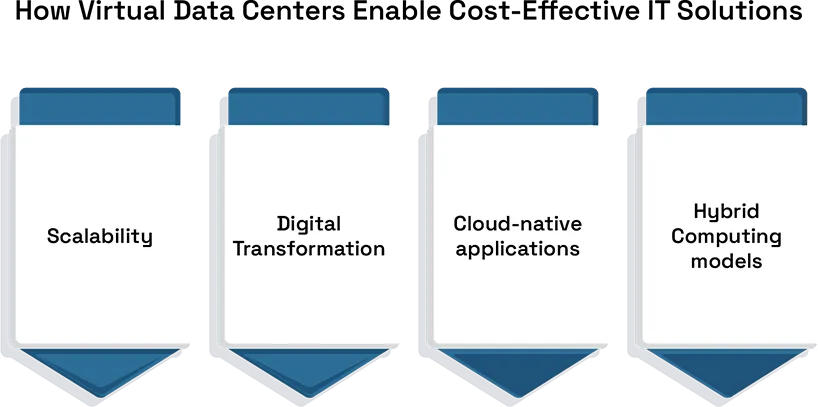As organizations are facing a challenge to acquire flexibility with high degrees of scalability and efficiency, IT solutions are shifting to using virtual data centers, or VDCs. VDCs represent an architectural model of a virtual data center that emulates the physical data center model but with a greater scale and much lower costs. They enable organizations to run their computing resources within software-defined technologies, giving them the ability to expand information technology services without the boundaries of hardware constraints.
These changes in the analytics infrastructure correlate with the changes in the general business environment focused on digital transformation on virtual, hybrid, and cloud computing models, as well as a shift toward cloud-native applications. Because of the virtual environment, automation software, and network mechanisms, organizations do not consider VDCs as an additional option but as a solution that can enhance the organization by diminishing costs. Here is how the virtual data center enforces cost-efficient IT solutions in 2025.

Reduced Hardware Investment Through Virtualization
Those virtual systems free businesses from high initial investments in physical assets, including servers, storage, and networks. Although there are numerous benefits to having several physical servers, many companies have turned to virtualization and have several virtual machines on each physical server. This is also in addition to preserving space and greatly diminishing the rates at which hardware is worn out or requires replacement.
Also, a part of hardware abstraction is that IT staff do not need to worry about new installations of applications and services. It also minimizes lead times so as to accelerate the time taken to introduce new changes on different projects. By the year 2025, with the evolution of newer hypervisors and containers, businesses will be in a position to fully virtualize all their workloads at cheaper costs.
Scalable Resources That Match Business Demand
This is one of the key advantages of employing VDCs, namely the fact that they can be scaled up. Businesses can adjust the computing, storage, or networking infrastructure either up or down depending on the dynamics of the workload. This is relatively flexible to make sure that the organization is charged only for what they would require at specific times, unlike the traditional models that would allocate more resources in anticipation of high usage.
Scalability is therefore very crucial in current business organizations due to dynamism in the market. Regardless of whether web traffic increases or there is an introduction of a new product, the VDC gives the ability to allocate resources immediately. Scalability of computing resources in 2025, with cloud-native orchestration tools and advanced workload computing artificial intelligence, will also continue to increase the availability of efficient and cost-sensitive additional computational resources.

Lower Operational and Energy Costs
Potential benefits of VDCs include reduction of power consumption and cooling needs since physical resources are significantly reduced. Conventional data centers require a lot of power to supply to the server and to cool so that they do not overheat. VDCs, on the other hand, use virtual environments that are hosted in low-energy-intensity facilities, and therefore, their energy expenses are reasonable.
Additionally, expenses that are used for the operations of the company are also reduced due to minimal efforts that are channeled toward manual labor. Since many functions, such as the procurement, control, or management of computational assets, are mechanized, organizations can employ fewer numbers of IT specialists without affecting efficiency. These are additional advantages, next to subscription-based pricing, that make it easier for a business entity to budget for its expenses incurred on IT services.
Centralized Management and Automation
Virtual data centers thus allow for the central control of the IT asset through web-based consoles as well as consolidated management interfaces. It means that through the management console, various tasks related to virtual environment management can be performed, which facilitates decision-making for IT administrators. That centralized approach helps simplify compliance, security, and performance of the organization at a broader level as compared to the functional level.
Cost reduction is one of the primary benefits that can be achieved by automating the work in VDC environments in 2025. Some of the common jobs, such as load balancing, backup, and disaster recovery can be done by the computer, thus eliminating the possibility of a human being making mistakes. This integration with DevOps pipelines proves another advantage for the firm, as the period within which it takes to develop new solutions is hastened, reducing the overall cost.
Built-In Redundancy and Disaster Recovery at Lower Costs
Business continuity is very important for any business but the conventional methods of duplication of physical disaster recovery infrastructure are very costly. The VDCs gave cost advantages that can effectively replace hardware redundancies and high availability in cloud-native designs. Redundancy, data backup, and failover features may also be incorporated into the service.
These features will enable businesses to have availability and ensure that they can quickly resume any business operations that were interrupted without having to invest in another data center. New advanced features such as geo-redundancy, automated snapshots, and cross-region failover, currently in existence in 2025, are more comprehensive than in the traditional models, yet cheaper. It also makes enterprise-grade resilience available in even the smallest and medium-sized organizations.
Thus, virtual data centers are not solely about the economies—they are an investment in business flexibility, solidity, and potential. Indeed, by effectively outsourcing physical infrastructure, the company can introduce a scalable platform and reduce organizational overhead, thus being more equipped to seize opportunities. With the advancement of information technology, VDCs will still stand as core providers of cost-effective and future-fit IT solutions.








